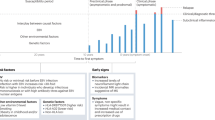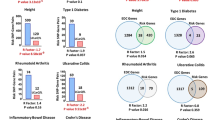Abstract
Epstein-Barr virus (EBV) infection, history of infectious mononucleosis (IM) and HLA-A and DRB1 have all been proposed as risk factors for multiple sclerosis (MS). Our aim was to analyse possible interactions between antibodies against Epstein-Barr virus nuclear antigen 1 (EBNA1) or EBNA1 fragments, presence of DRB1*15 and absence of A*02. The study population includes newly diagnosed cases and matched controls. Interaction on the additive scale was calculated using attributable proportion due to interaction (AP), which is the proportion of the incidence among individuals exposed to two interacting factors that is attributable to the interaction per se. IM showed association with MS, odds ratio (OR)=1.89 (1.45–2.48% confidence interval (CI)), as did raised EBNA1 IgG OR=1.74 (1.38–2.18 95%CI). All EBNA1 fragment IgGs were associated with MS risk. However, EBNA1 fragment 385–420 IgG levels were more strongly associated to MS than total EBNA1 IgG, OR=3.60 (2.75–4.72 95%CI), and also interacted with both DRB1*15 and absence of A*02, AP 0.60 (0.45–0.76 95%CI) and AP 0.39 (0.18–0.61 95%CI), respectively. The observed interaction between HLA class I and II genotype and reactivity to EBV-related epitopes suggest that the mechanism through which HLA genes influence the risk of MS may, at least in part, involve the immune control of EBV infection.
This is a preview of subscription content, access via your institution
Access options
Subscribe to this journal
Receive 6 digital issues and online access to articles
$119.00 per year
only $19.83 per issue
Buy this article
- Purchase on Springer Link
- Instant access to full article PDF
Prices may be subject to local taxes which are calculated during checkout

Similar content being viewed by others
References
Brynedal B, Duvefelt K, Jonasdottir G, Roos IM, Akesson E, Palmgren J et al. HLA-A confers an HLA-DRB1 independent influence on the risk of multiple sclerosis. PLoS One 2007; 2: e664.
Handel AE, Giovannoni G, Ebers GC, Ramagopalan SV . Environmental factors and their timing in adult-onset multiple sclerosis. Nat Rev Neurol 2010; 6: 156–166.
Leibowitz U, Antonovsky A, Medalie JM, Smith HA, Halpern L, Alter M . Epidemiological study of multiple sclerosis in Israel. II. Multiple sclerosis and level of sanitation. J Neurol Neurosurg Psychiatry 1966; 29: 60–68.
Ascherio A, Munger KL . Environmental risk factors for multiple sclerosis. Part I: the role of infection. Ann Neurol 2007; 61: 288–299.
Hunter SF, Hafler DA . Ubiquitous pathogens: Links between infection and autoimmunity in MS? Neurology 2000; 55: 164–165.
Ascherio A, Munger KL . Epstein-barr virus infection and multiple sclerosis: a review. J Neuroimmune Pharmacol 2010; 5: 271–277.
Ascherio A, Munger KL, Lennette ET, Spiegelman D, Hernan MA, Olek MJ et al. Epstein-Barr virus antibodies and risk of multiple sclerosis: a prospective study. JAMA 2001; 286: 3083–3088.
Sundstrom P, Juto P, Wadell G, Hallmans G, Svenningsson A, Nystrom L et al. An altered immune response to Epstein-Barr virus in multiple sclerosis: a prospective study. Neurology 2004; 62: 2277–2282.
Sundstrom P, Nystrom M, Ruuth K, Lundgren E . Antibodies to specific EBNA-1 domains and HLA DRB1*1501 interact as risk factors for multiple sclerosis. J Neuroimmunol 2009; 215: 102–107.
Hosmer DW, Lemeshow S . Confidence interval estimation of interaction. Epidemiology 1992; 3: 452–456.
Rothman KJ . Epidemiology: An Introduction. Oxford University Press: New York, NY, 2002, viii, 223pp.
Sundstrom P, Nystrom L, Jidell E, Hallmans G . EBNA-1 reactivity and HLA DRB1*1501 as statistically independent risk factors for multiple sclerosis: a case-control study. Mult Scler 2008; 14: 1120–1122.
De Jager PL, Simon KC, Munger KL, Rioux JD, Hafler DA, Ascherio A . Integrating risk factors: HLA-DRB1*1501 and Epstein-Barr virus in multiple sclerosis. Neurology 2008; 70 (Pt 2): 1113–1118.
Nielsen TR, Rostgaard K, Askling J, Steffensen R, Oturai A, Jersild C et al. Effects of infectious mononucleosis and HLA-DRB1*15 in multiple sclerosis. Mult Scler 2009; 15: 431–436.
Simon KC, van der Mei IA, Munger KL, Ponsonby A, Dickinson J, Dwyer T et al. Combined effects of smoking, anti-EBNA antibodies, and HLA-DRB1*1501 on multiple sclerosis risk. Neurology 2010; 74: 1365–1371.
Goodin DS . The causal cascade to multiple sclerosis: a model for MS pathogenesis. PLoS One 2009; 4: e4565.
Levin LI, Munger KL, O'Reilly EJ, Falk KI, Ascherio A . Primary infection with the Epstein-Barr virus and risk of multiple sclerosis. Ann Neurol 2010; 67: 824–830.
Pender MP . Preventing and curing multiple sclerosis by controlling Epstein-Barr virus infection. Autoimmun Rev 2009; 8: 563–568.
Niller HH, Wolf H, Minarovits J . Regulation and dysregulation of Epstein-Barr virus latency: implications for the development of autoimmune diseases. Autoimmunity 2008; 41: 298–328.
Rand KH, Houck H, Denslow ND, Heilman KM . Molecular approach to find target(s) for oligoclonal bands in multiple sclerosis. J Neurol Neurosurg Psychiatry 1998; 65: 48–55.
Steinman L . A molecular trio in relapse and remission in multiple sclerosis. Nat Rev Immunol 2009; 9: 440–447.
Li Q, Spriggs MK, Kovats S, Turk SM, Comeau MR, Nepom B et al. Epstein-Barr virus uses HLA class II as a cofactor for infection of B lymphocytes. J Virol 1997; 71: 4657–4662.
Serafini B, Rosicarelli B, Franciotta D, Magliozzi R, Reynolds R, Cinque P et al. Dysregulated Epstein-Barr virus infection in the multiple sclerosis brain. J Exp Med 2007; 204: 2899–2912.
Serafini B, Severa M, Columba-Cabezas S, Rosicarelli B, Veroni C, Chiappetta G et al. Epstein-Barr virus latent infection and BAFF expression in B cells in the multiple sclerosis brain: implications for viral persistence and intrathecal B-cell activation. J Neuropathol Exp Neurol 2010; 69: 677–693.
Aloisi F, Serafini B, Magliozzi R, Howell OW, Reynolds R . Detection of Epstein-Barr virus and B-cell follicles in the multiple sclerosis brain: what you find depends on how and where you look. Brain 2010; 133 (Pt 12): e157.
Casiraghi C, Dorovini-Zis K, Horwitz MS . Epstein-Barr virus infection of human brain microvessel endothelial cells: a novel role in multiple sclerosis. J Neuroimmunol 2011; 230: 173–177.
Zivadinov R, Weinstock-Guttman B, Zorzon M, Uxa L, Serafin M, Bosco A et al. Gene-environment interactions between HLA B7/A2, EBV antibodies are associated with MRI injury in multiple sclerosis. J Neuroimmunol 2009; 209: 123–130.
McAulay KA, Higgins CD, Macsween KF, Lake A, Jarrett RF, Robertson FL et al. HLA class I polymorphisms are associated with development of infectious mononucleosis upon primary EBV infection. J Clin Invest 2007; 117: 3042–3048.
Hjalgrim H, Rostgaard K, Johnson PC, Lake A, Shield L, Little AM et al. HLA-A alleles and infectious mononucleosis suggest a critical role for cytotoxic T-cell response in EBV-related Hodgkin lymphoma. Proc Natl Acad Sci USA 2010; 107: 6400–6405.
Luzuriaga K, Sullivan JL . Infectious mononucleosis. N Engl J Med 2010; 362: 1993–2000.
Hedstrom AK, Baarnhielm M, Olsson T, Alfredsson L . Tobacco smoking, but not Swedish snuff use, increases the risk of multiple sclerosis. Neurology 2009; 73: 696–701.
Ramagopalan SV, Knight JC, Ebers GC . Multiple sclerosis and the major histocompatibility complex. Curr Opin Neurol 2009; 22: 219–225.
Olerup O, Zetterquist H . HLA-DR typing by PCR amplification with sequence-specific primers (PCR-SSP) in 2 hours: an alternative to serological DR typing in clinical practice including donor-recipient matching in cadaveric transplantation. Tissue Antigens 1992; 39: 225–235.
Andersson T, Alfredsson L, Kallberg H, Zdravkovic S, Ahlbom A . Calculating measures of biological interaction. Eur J Epidemiol 2005; 20: 575–579.
Acknowledgements
The study was supported by grants from the Swedish Association for Persons with Neurological Disabilities, The Swedish Research Council, The Söderbergs Foundation, the AFA foundation, the Swedish Foundation for Working Life and Social research and the FP6 program Neuropromise (LSHM-CT-2005-018637). We thank Nina Nordin and Karin Kai-Larsen for help with collecting data.
Author contributions: ES did HLA genotyping and the statistical analysis, provided figures and wrote the paper. PS provided reagents and performed the anti-EBV antibody measurements. ML did HLA genotyping. AKH collected clinical information on the EIMS participants. FA contributed to writing of the paper. IK supervised HLA genotyping and the statistical analysis. JH, LA and TO are responsible for the EIMS study and the design of the study. All authors contributed to the final paper.
Author information
Authors and Affiliations
Corresponding author
Ethics declarations
Competing interests
Ms Sundqvist has received research support from the Swedish Association for Persons with Neurological Disabilities. Professor Hillert has received unrestricted research support from BiogenIdec, MerckSerono and Bayer Schering. Professor Alfredsson receives research support from the Swedish Medical Research Council (Dnr 521-2009-2596) and Swedish Council for Working life and Social Research (Dnr 2009-0650). Professor Tomas Olsson has received grant support for MS research from unrestricted grant support from BiogenIdec, Bayer, SanofiAventis and Merck, and also lecture fees and/or advisory board consultancies for the same companies. Other authors declare no conflict of interest.
Additional information
Supplementary Information accompanies the paper on Genes and Immunity website
Supplementary information
Rights and permissions
About this article
Cite this article
Sundqvist, E., Sundström, P., Lindén, M. et al. Epstein-Barr virus and multiple sclerosis: interaction with HLA. Genes Immun 13, 14–20 (2012). https://doi.org/10.1038/gene.2011.42
Received:
Revised:
Accepted:
Published:
Issue Date:
DOI: https://doi.org/10.1038/gene.2011.42



